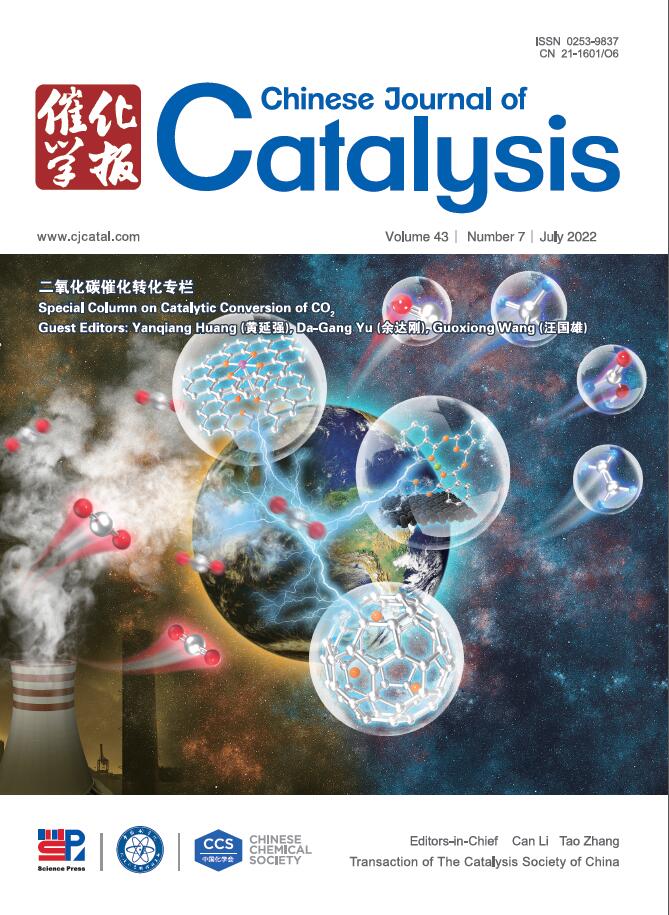高分散MoOx-Ru/C双金属催化剂,用于酯类高效氢解制烷烃
IF 15.7
1区 化学
Q1 CHEMISTRY, APPLIED
引用次数: 0
摘要
将酯高效氢解为烷烃是利用可再生植物油或脂肪生产高级生物燃料的关键方案。由于酯类中羰基的反应活性较低,因此高反应温度(250 °C)是确保酯类高转化率的先决条件。在此,我们报告了一种高度分散的 MoOx-Ru/C 双金属催化剂,用于在 150 °C 下将酯高效氢解为烷烃。最佳催化剂的硬脂酸甲酯转化率为 99%,对柴油范围烷烃的选择性为 99%,转化率高达 2.0 mmol gcat-1 h-1,是 Ru/C 催化剂的 5 倍(MoOx/C 为惰性)。综合实验和理论研究结果表明,催化剂表面丰富的 MoOx-Ru 界面位点为酯的 C-O 裂解提供了高活性,从而实现了高性能。此外,分散的 MoOx 物种大大削弱了金属 Ru 对 C-C 键的加氢裂化活性,从而在不损失碳的情况下生成烷烃产品。这项研究为设计高性能异相催化剂提供了一种简便而新颖的策略,用于将生物质衍生酯加氢脱氧生成烷烃产品。本文章由计算机程序翻译,如有差异,请以英文原文为准。
Highly dispersed MoOx-Ru/C bimetallic catalyst for efficient hydrogenolysis of esters to alkanes
The efficient hydrogenolysis of esters to alkanes is the key protocol for producing advanced biofuels from renewable plant oils or fats. Due to the low reactivity of the carbonyl group in esters, a high reaction temperature (>250 °C) is the prerequisite to ensure high conversion of esters. Here, we report a highly dispersed MoOx-Ru/C bimetallic catalyst for the efficient hydrogenolysis of esters to alkanes under 150 °C. The optimal catalyst exhibits >99% conversion of methyl stearate and 99% selectivity to diesel-range alkanes, reaching a high rate of up to 2.0 mmol gcat–1 h–1, 5 times higher than that of Ru/C catalyst (MoOx/C is inert). Integrated experimental and theoretical investigations attribute the high performance to the abundant MoOx-Ru interfacial sites on the catalyst surface, which offers high activity for the C–O cleavage of esters. Furthermore, the dispersed MoOx species significantly weaken the hydrocracking activity of the metallic Ru for C–C bonds, thus yielding alkane products without carbon loss. This study provides a facile and novel strategy for the design of high-performance heterogeneous catalysts for the hydrodeoxygenation of biomass-derived esters to alkane products.
求助全文
通过发布文献求助,成功后即可免费获取论文全文。
去求助
来源期刊

Chinese Journal of Catalysis
工程技术-工程:化工
CiteScore
25.80
自引率
10.30%
发文量
235
审稿时长
1.2 months
期刊介绍:
The journal covers a broad scope, encompassing new trends in catalysis for applications in energy production, environmental protection, and the preparation of materials, petroleum chemicals, and fine chemicals. It explores the scientific foundation for preparing and activating catalysts of commercial interest, emphasizing representative models.The focus includes spectroscopic methods for structural characterization, especially in situ techniques, as well as new theoretical methods with practical impact in catalysis and catalytic reactions.The journal delves into the relationship between homogeneous and heterogeneous catalysis and includes theoretical studies on the structure and reactivity of catalysts.Additionally, contributions on photocatalysis, biocatalysis, surface science, and catalysis-related chemical kinetics are welcomed.
 求助内容:
求助内容: 应助结果提醒方式:
应助结果提醒方式:


